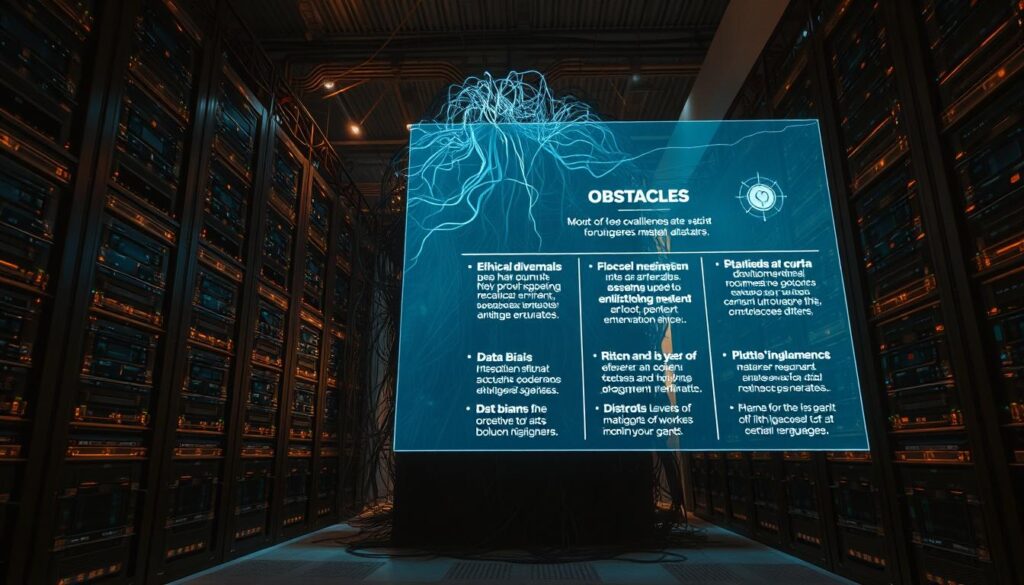Did you know that over 37% of businesses are now leveraging Artificial Intelligence to optimize their operations? The AI revolution transcends mere buzz; it’s a transformative force reshaping sectors from healthcare to finance. This guide serves as your entry point to grasp the profound impact and vast potential of AI, delving into its complexities for a comprehensive overview.
Artificial Intelligence, or Cognitive Computing, is ushering in unprecedented efficiency and innovation. This guide will navigate you through AI’s intricacies, from its foundational principles to its most advanced applications. By the conclusion, you will possess a nuanced understanding of AI’s transformative influence and its strategic application in business.
To initiate your exploration, let’s examine an in-depth resource that delves into AI’s essence. For a more detailed analysis, refer to this blog post on Artificial Intelligence.
Key Takeaways
- Over 37% of businesses are now integrating AI to enhance operations.
- AI is a cornerstone of the new cognitive computing era.
- This guide will cover fundamental principles to advanced applications of AI.
- AI’s influence spans across multiple sectors including healthcare and finance.
- Understanding AI is crucial for leveraging its potential in business strategies.
Understanding Artificial Intelligence: A Comprehensive Overview
In today’s rapidly advancing technological landscape, grasping the fundamentals of artificial intelligence (AI) is essential. This section aims to demystify AI, breaking down complex concepts and terminologies crucial for understanding intelligent systems.
What is Artificial Intelligence?
Artificial Intelligence refers to the simulation of human intelligence in machines. These machines are programmed to think like humans and mimic their actions. They are designed to perform tasks such as learning, problem-solving, and decision-making, which traditionally require human intelligence.
Key Terminology in AI
To grasp the intricacies of artificial intelligence, it’s essential to understand certain key terms:
- Machine Learning: A subset of AI that involves training algorithms to learn from and make predictions based on data.
- Deep Learning: A subset of machine learning involving neural networks with many layers, which mimic the human brain’s function.
- AI Algorithms: Step-by-step procedures used by machines to perform AI tasks such as classification, prediction, and optimization.
Types of AI: Narrow vs. General
Artificial intelligence can be categorized into two main types:
- Narrow AI: Designed to perform a specific task, such as speech recognition or image classification. These systems use advanced AI algorithms, yet they operate within a limited scope.
- General AI: These systems possess the potential to perform any intellectual task that a human can. General AI is more complex and ambitious, aiming to replicate broad cognitive functions.
The History of Artificial Intelligence Development
The evolution of artificial intelligence (AI) is a captivating narrative, punctuated by crucial milestones. These events have profoundly shaped AI’s trajectory, from its theoretical beginnings to today’s cutting-edge advancements. This journey has been guided by visionary individuals and groundbreaking innovations. We explore the key moments and figures that have advanced AI.
Milestones in AI History
The history of AI is replete with milestones that have significantly influenced the field. A pivotal moment was the introduction of the Turing Test by Alan Turing in 1950. This test established a benchmark for assessing a machine’s intelligence, determining if it could mimic human behavior.
In 1966, ELIZA, an early natural language processing program, was developed at MIT. This achievement highlighted AI’s potential in understanding and responding to human language.
By 1997, IBM’s Deep Blue had defeated world chess champion Garry Kasparov, demonstrating AI’s capability in solving complex problems. The advent of robotics and advanced computer vision technologies has further transformed AI. These advancements have enabled machines to perceive and interact with their environment in ways previously unimaginable.
Key Figures in AI Evolution
The development of AI has been significantly shaped by visionary individuals. Alan Turing, often hailed as the father of AI, not only introduced the Turing Test but also laid the foundational principles of theoretical computer science.
John McCarthy, who coined the term “artificial intelligence” in 1956, played a crucial role in AI’s development. He was instrumental in creating the Lisp programming language, a vital tool for AI research. Marvin Minsky, a close collaborator of McCarthy, established the first AI laboratory at MIT. This laboratory became a hub for innovative AI research and development.
Geoffrey Hinton’s work on neural networks has been instrumental in advancing machine learning. His contributions have significantly influenced computer vision and autonomous systems. Hinton’s ongoing influence continues to drive innovation in AI technologies.
How Artificial Intelligence Works: The Basics
To grasp the essence of artificial intelligence, one must explore its fundamental mechanisms. This involves examining the roles of AI Algorithms, Neural Networks, and Natural Language Processing (NLP). Such an exploration offers insight into cognitive computing and its myriad applications.
Algorithms and Machine Learning
AI algorithms are the core of machine learning, allowing computers to discern patterns in data and forecast outcomes. These algorithms are designed to evolve, enhancing their precision and speed with each iteration. For example, AI algorithms in predictive maintenance enable industries to anticipate equipment failures ahead of time.
Neural Networks Explained
Neural networks replicate the human brain’s complex neuron connections. They comprise layers of nodes, each processing data to convert input into actionable output. As neural networks advance, their deep learning capabilities expand, enabling tasks like image and speech recognition. A prime example is their application in autonomous vehicles, where they analyze and interpret sensory data instantaneously.
Natural Language Processing
Natural Language Processing (NLP) equips computers to comprehend and generate human language. Through NLP, AI systems can dissect text, identify speech, and engage in dialogue. This technology is crucial in virtual assistants (e.g., Siri and Alexa), which rely on NLP to interpret user queries and offer pertinent responses. The integration of NLP with cognitive computing is redefining human-computer interaction, making it more intuitive and seamless.
Key Applications of Artificial Intelligence Today
Artificial Intelligence (AI) is rapidly transforming diverse sectors by leveraging Intelligent Systems, Data Analysis, and Predictive Analytics. The following sections underscore the groundbreaking ways AI is being utilized in healthcare, finance, and transportation to maximize efficiency and innovation.
AI in Healthcare
The healthcare sector has experienced substantial advancements due to the integration of AI. Intelligent Systems assist in enhancing diagnostic accuracy and improving patient outcomes. Through sophisticated Data Analysis, AI aids clinicians in identifying potential health risks and personalizing treatment plans.
Further, Predictive Analytics plays a crucial role in predicting disease outbreaks and managing patient care more efficiently. Innovations such as AI-powered imaging and robotic surgery are reshaping modern medical practices, leading to improved healthcare delivery. Explore more about these AI applications in healthcare.
AI in Finance
In the finance industry, AI applications have revolutionized the way financial data is analyzed and utilized. Predictive Analytics allows financial institutions to forecast market trends, assess risks, and make data-driven decisions. Intelligent Systems are employed to automate complex trading strategies, optimize portfolios, and enhance fraud detection rates.
AI technologies also streamline customer interactions through personalized financial advice and efficient customer service chatbots. By accelerating Data Analysis, financial institutions can offer more robust and tailored services to their clients.
AI in Transportation
The transportation sector is witnessing significant improvements with the adoption of AI technologies. Intelligent Systems enhance the efficiency and safety of transportation networks through optimized route planning and traffic management. Autonomous vehicles, powered by sophisticated AI algorithms, promise safer and more reliable transit options.
Predictive Analytics aids in managing transportation logistics by forecasting maintenance needs and reducing operational disruptions. AI-driven initiatives are not only contributing to smoother transportation networks but are also paving the way for innovations like drone deliveries and intelligent mobility services.
It’s clear that from healthcare to finance and transportation, AI is setting a new standard of excellence and efficiency. These Intelligent Systems, Data Analysis, and Predictive Analytics are just the beginning of a revolution that is poised to reshape numerous facets of our daily lives.
Benefits of Implementing Artificial Intelligence
Adopting artificial intelligence in your business strategy is a pivotal move, offering significant advantages. Through automation, AI transforms operations, enhancing efficiency and productivity across multiple industries.
Increased Efficiency and Productivity
Automation automates mundane tasks, freeing human resources for more creative and strategic work. AI Solutions enable rapid data processing and analysis. This allows your team to concentrate on tasks that drive growth and innovation.
Enhanced Decision-Making
The advent of Big Data has provided businesses with unparalleled access to information. AI Solutions rapidly analyze vast datasets, delivering insights that inform better decision-making. Advanced analytics predict market trends, understand consumer behavior, and optimize supply chains.
Cost Savings and Resource Optimization
Implementing AI can lead to substantial cost savings through optimized resource utilization. Automation reduces labor costs and boosts operational efficiency. AI-driven predictive maintenance minimizes equipment downtime, preventing costly disruptions and extending equipment lifespan.
The adaptability of AI Solutions and the power of Big Data analytics give your business a competitive edge. By embracing AI, you leverage enhanced operational efficiency, data-driven decision-making, and optimal resource allocation.
Challenges Facing Artificial Intelligence

Artificial intelligence’s growth is hindered by several obstacles, necessitating a focus on its ethical and effective deployment. This discussion explores key hurdles such as AI ethics, data security, and the constraints of current machine learning capabilities.
Ethical Considerations
AI ethics stands as a critical concern. It involves ensuring AI systems are unbiased, transparent, and in line with human values. This entails preventing AI’s discriminatory effects and guaranteeing that autonomous systems uphold human rights.
Data Privacy Issues
Data security is a significant challenge in AI. AI’s reliance on vast data sets to operate efficiently underscores the need for robust protection against unauthorized access and breaches. Implementing stringent data privacy measures is essential to safeguard user data.
Limitations of Current AI Systems
Despite notable progress, current AI systems face inherent limitations. These include difficulties in grasping context and nuances without human oversight. The machine learning limitations are evident in AI’s lack of common sense and its inability to adapt to new scenarios without retraining. Addressing these constraints is vital for AI’s future advancement.
The Future of Artificial Intelligence
The advent of artificial intelligence heralds a transformative era across multiple sectors. As innovations in AI continue to evolve, they are poised to revolutionize our daily lives and professional environments. This raises critical inquiries regarding the employment landscape in the AI era.
Emerging Trends in AI
One of the most anticipated AI Trends is the fusion of AI with other advanced technologies. For example, the integration of AI with blockchain for secure data exchange or the deployment of AI in IoT devices to enhance smart home functionalities. These advancements are expected to redefine the limits of what is achievable.
Potential Impacts on Employment
Despite the promising prospects of AI Innovation, its influence on employment is a pressing concern. The need for a skilled workforce to adapt to AI-driven roles is paramount. Embracing continuous learning and retraining will be essential for maintaining relevance in the dynamic job market.
Innovations on the Horizon
Future AI breakthroughs may include enhanced human-AI collaboration, leading to increased productivity and creativity. Advances in AI could also pave the way for more tailored and effective healthcare, enabling early disease detection and personalized treatment plans. These developments hold immense potential for societal progress.
Implementing AI in Your Business Strategy

Integrating AI into your business strategy requires a comprehensive approach. It starts with identifying your needs, choosing the right solutions, and assessing outcomes. This guide will walk you through these steps to optimize your AI Integration and boost your Business Intelligence.
Assessing Your Business Needs
Before starting your AI journey, it’s crucial to evaluate your organization’s needs. Conduct a SWOT analysis to pinpoint areas where AI can enhance efficiency. Ask if your current processes can benefit from automation or if predictive analytics can streamline decision-making.
Choosing the Right AI Solutions
Choosing the right AI tools is vital for your business’s success. Consider partnering with trusted AI providers like IBM Watson or Google’s AI platform. Look for tools that offer flexibility, scalability, and seamless integration with existing systems. Leveraging AI Integration for tasks like customer support, data analysis, and supply chain management can bring significant benefits.
Measuring AI Success and ROI
After implementing AI, it’s essential to measure its effectiveness to ensure a substantial Return on Investment. Define key performance indicators (KPIs) that align with your business goals, such as increased productivity, cost savings, or enhanced customer satisfaction. Use Business Intelligence tools to track these metrics and refine your AI strategy. Regularly assessing these outcomes is key to sustaining and optimizing AI initiatives.
Resources for Further Learning About AI
The realm of artificial intelligence is in a state of constant transformation. To remain abreast, one must commit to ongoing education and active community participation. This commitment is vital, whether you are an experienced professional or a novice in AI. A plethora of resources awaits to aid in your educational journey. This includes books, online courses, certifications, professional organizations, and conferences. These tools are designed to enrich your understanding and foster connections within the AI community.
Books and Publications
The field of AI is extensively documented in literature, offering deep insights into its various facets. “Artificial Intelligence: A Modern Approach” by Stuart Russell and Peter Norvig stands as a cornerstone text. For those seeking contemporary perspectives and practical applications, “Life 3.0: Being Human in the Age of Artificial Intelligence” by Max Tegmark is a recommended read. Journals like the “Journal of Artificial Intelligence Research” (JAIR) and “AI Magazine” are also invaluable for keeping up with the latest research and industry developments.
Online Courses and Certifications
Online courses and certifications offer a flexible, accessible route to mastering AI. Platforms like Coursera and edX feature courses from esteemed institutions such as Stanford University and MIT. For a more structured learning experience, consider obtaining certifications from reputable sources like the Stanford Online AI Certificate, Google’s AI courses, or the IBM AI Engineering Professional Certificate. These programs are crafted to enhance your skills, playing a significant role in your AI education.
Professional Organizations and Conferences
Participation in professional organizations and attendance at conferences can greatly enrich your AI community engagement. Bodies such as the Association for the Advancement of Artificial Intelligence (AAAI) and the IEEE Computational Intelligence Society provide a wealth of resources. These include webinars, workshops, and networking opportunities. Conferences like the North American Conference on AI (AAAI Conference) and NeurIPS (Conference on Neural Information Processing Systems) offer invaluable platforms. They allow for learning from experts, exposure to groundbreaking research, and networking with peers. These gatherings are essential for maintaining a current and connected stance within the ever-evolving AI landscape.

